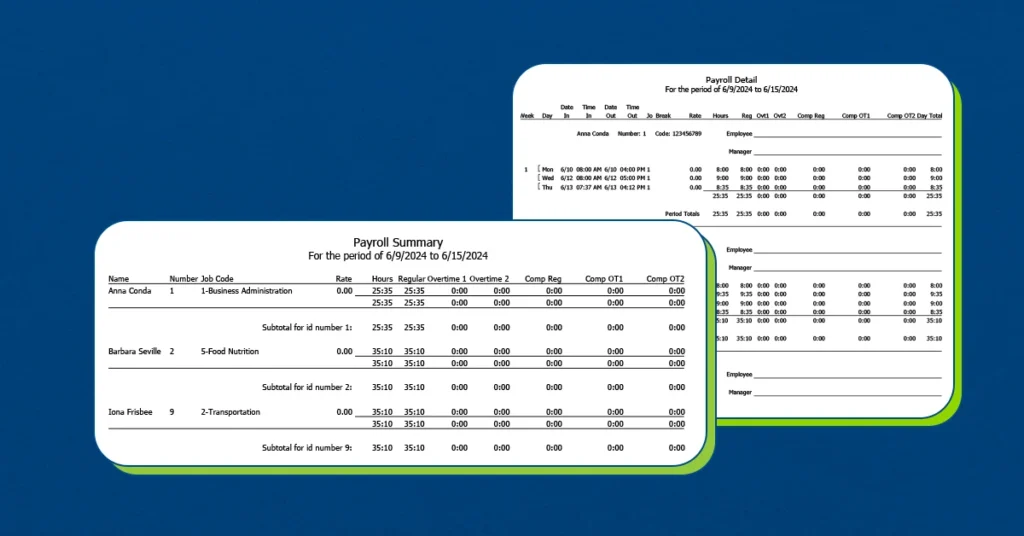Not every job happens between 9 and 5. If your organization runs overnight, on weekends, or around the clock, you know how tough it can be to staff those off-hour shifts (and how valuable the people who take them really are).
Shift differential pay helps close that coverage gap.
By offering extra compensation for less desirable hours, you can attract and retain employees willing to cover critical shifts without burning out your team or overextending your budget. This guide breaks down how shift differential pay works, how to calculate it, and how to build a policy to keep your payroll accurate and your operations covered.
What is shift differential pay?
Shift differential pay is an extra amount added to an employee’s regular wages for working outside standard business hours:
- Usually a flat dollar rate or a percentage of base pay
- Most often used for nights, weekends, or holidays
- Can apply to hazardous roles or less desirable tasks
Unlike overtime, shift differentials aren’t a federal requirement. But they’re a common incentive to encourage coverage for hard-to-fill shifts and help employers stay competitive in industries that rely on 24/7 or round-the-clock staffing.
Both hourly and salaried employees can receive shift differential pay. Eligibility and pay structure differ between organizations, but shift differentials should be clearly defined in your payroll system and communicated in your time and attendance policies.
Criteria for a shift differential
There’s no universal rule for when to offer shift differential pay. “It depends” might sound like a non-answer, but your operations, workforce, and scheduling needs impact your shift differential policy. That said, shift differential criteria can include:
- Time of day – Commonly applied to second, third, or graveyard shifts (e.g., 3–11 p.m., 11 p.m.–7 a.m.).
- Day of the week – Weekends or holidays often come with premiums to encourage coverage/
- Work location – Some organizations offer differentials for remote, offshore, or high-risk environments.
- Job type or responsibilities – Critical roles, extra duty work, or hazardous tasks may carry extra pay.
- Union or contract terms – Collective bargaining agreements (CBAs) frequently define shift differential rules in detail.
- Emergency or short-notice coverage – Some organizations offer temporary differentials for shifts picked up at the last minute.
Your policy doesn’t need to include all of these, but it should be consistent, documented, and easy for managers to apply and track.
Types of shift differential pay
How you structure shift differential pay is up to you. The three most common formats are:
Percentage-based shift differential
A percentage increase applied to an employee’s base pay. For example, 10% extra for night shifts means a $25/hour employee earns $27.50/hour during qualifying hours.
Shift-specific shift differential
A fixed dollar amount is added per hour for working certain shifts (like weekends or graveyard shifts), regardless of the employee’s base rate.
Flat rate shift differential
Instead of applying pay rules by time of day, some organizations define differentials by the shift itself. For example, “third shift” pays $3/hour more than “first shift,” no matter the exact start time.
All three formats can work. The key is to pick the one that fits your workforce size, payroll tools, and reporting needs, then apply it consistently.
Shift differential vs. overtime
Shift differential and overtime are both types of premium pay, but they follow different rules and regulations.
- Overtime is federally required (under the Fair Labor Standards Act) and kicks in once an employee exceeds 40 hours in a workweek. It’s typically paid at 1.5x the employee’s regular rate.
- Shift differential is optional and applies to specific hours or shifts, independent of overtime and regardless of the amount the employee works.
An employee can earn both in the same week, say, if they work night shifts (with a differential) and go over 40 hours. In those cases, the overtime rate is often calculated based on the blended rate, which includes the differential.
If your payroll system doesn’t calculate that automatically, it’s easy to miscalculate wages, which can lead to potential compliance issues or underpaid employees. That’s why many teams rely on time and attendance software to manage the overlap.
Pros and cons of offering shift differential pay
Offering shift differential pay can give you more flexibility in scheduling and help attract employees to cover nights, weekends, and holidays. But like any pay strategy, it’s not without tradeoffs. Here’s what you should consider.
| Pros | Cons |
| Better shift coverage Off-hours get filled more reliably when there’s extra pay on the table. | Adds payroll complexity Without the right software, tracking and calculating differentials can create admin overhead. |
| Improved employee morale Extra pay shows respect for working less desirable shifts. | Budget unpredictability Without boundaries, differential payouts can grow quickly and complicate labor planning. |
| Recruitment advantage Can help attract candidates who prioritize flexibility or higher earning potential. | Potential for friction If applied inconsistently or without transparency, differentials can cause internal resentment. |
| Fair compensation for tougher shifts Recognizes the value of inconvenient or higher-stress work hours. | Teams will have to find other problems It’s hard to argue with the rationale of fairly paying people who step up. Which means complaints will go elsewhere. |
A good shift differential pay policy — and the right software to back it — can help you sidestep the downsides while maximizing the upside.
How to calculate shift differential pay
Many organizations use time and attendance software to serve as its shift differential calculator and automatically take care of shift differential pay. But if you choose to calculate shift differential pay manually, you can’t risk getting your calculations incorrect.
Here are the basic steps.
- Step 1 – Start with your standard pay rate
- Step 2 – Determine your differential pay method
- Step 3 – Multiply your pay rate by the differential rate
- Step 4 – Add the differential value to the regular pay rate
Let’s apply these steps in two different real-world scenarios:
Example of percentage-based differential pay
Travis works for a semiconductor manufacturer at $30 per hour and chooses to work all 40 hours of the week on the night shift with a 15% differential. His pay is calculated as follows:
Regular pay rate: $30 per hour
Differential value: $30 x .15 = $4.50
Total hourly pay: $30 + $4.50 = $34.50
Total weekly pay: 40 hours x $34.50 = $1,380
If Travis chooses to work only two night shifts of 8 hours each during the 40-hour week, the calculation adjusts accordingly:
Regular pay rate: $30 per hour
Differential value: $30 x .15 = $4.50
Total hourly pay with shift differential: $30 + $4.50 = $34.50
Total weekly regular pay: $30 per hour x 24 = $720
Total weekly shift differential pay (for two night shifts): $34.50 x 16 = $552
Total weekly pay: $720 + $552 = $1,272
Example of flat rate differential pay
Looking at Travis as an example again. Instead of using percentages, you add a flat amount for his night shifts — let’s say that rate is $3/hour extra. Here’s how you would calculate differential pay for two night shifts of 8 hours each during the 40-hour week:
Regular pay rate: $30 per hour
Differential value: $30 + $3 per hour = $33 per hour
Total weekly regular pay: $30 per hour x 24 hours = $720
Total weekly shift differential pay (for two night shifts): $33 x 16 = $528
Total weekly pay: $720 + $528 = $1,248
How to calculate overtime with shift differentials
When an employee earns both shift differential and overtime in the same pay period, it’s not just a matter of multiplying their base rate by 1.5. You’ll likely need to use a blended rate.
Here’s a simplified example — let’s say an employee works 32 hours at their regular rate ($20/hour), and 8 hours on a night shift with a 25% differential ($25/hour).
Total pay before overtime:
32 x $20 = $640
8 x $25 = $200
Total regular pay = $840
Now, calculate the blended rate:
$840 ÷ 40 hours = $21/hour blended rate
Overtime (1.5x) kicks in for any hours beyond 40. So, if they work 45 hours total:
5 hours overtime x $31.50/hour (1.5 x $21) = $157.50 overtime pay
Total weekly pay = $840 + $157.50 = $997.50
Now imagine multiplying this process across dozens or hundreds of employees. Without the right tools, calculating these correctly every time is a fast track to payroll errors, hours of unnecessary admin work, and higher compliance risks.
Common questions with shift differentials, answered
Even if your organization already offers shift differential pay, you might still get questions from leadership, HR, or employees about how it works — and why it matters. Here are a few of the most common ones, with quick, practical answers you can pass along.
Which industries use shift differentials?
Shift differential pay is most common in industries that run beyond standard business hours or require coverage around the clock. These include:
- Healthcare – Nurses, hospital techs, EMTs, and support staff are scheduled to work nights, weekends, and holidays.
- Manufacturing and logistics – Production lines and warehouses frequently operate 24/7 and use staggered shifts to meet demand.
- Public safety – Firefighters, police, and dispatchers are routinely scheduled outside the 9-to-5 window.
- Transportation and utilities – Airlines, transit providers, and utility companies depend on off-hour operations and emergency coverage.
- Hospitality and retail – Hotels, restaurants, and customer support centers staff early mornings, late nights, and weekends.
Anywhere coverage is critical or where timing is unpredictable, shift differentials are likely in play.
Do shift differentials affect payroll tax?
Yes. Shift differential pay is considered part of an employee’s total compensation and is subject to the same federal, state, and local payroll taxes as regular wages. That includes Social Security and Medicare (FICA), federal/state income tax withholding, and unemployment insurance contributions.
Because of this, your payroll system must include shift differential pay in taxable income and apply all applicable tax rules, which are the same as base pay.
If your time tracking system doesn’t account for shift differentials, this may add complications if an employee is bumped into a different tax bracket (due to higher gross income).
What is the average shift differential?
There’s no single benchmark, but here’s what most organizations tend to offer:
| Shift Type | Typical Differential |
| Evening or night | 5%–15% of base pay, or $0.50–$3.00 per hour |
| Weekend | Flat rate of $1–$5 per hour, depending on the role |
| Holiday | Time-and-a-half, double time, or an additional fixed amount |
Keep in mind that your shift differential doesn’t have to match competitors’ dollar for dollar. It just needs to be enough to attract and retain the people you need, without compromising your labor budget or overcomplicating payroll.
Simplify shift differential pay with TCP Software
Shift differential pay shouldn’t slow down your payroll process or keep managers up at night wondering if they got the calculations right. With TimeClock Plus, you can automate even the most complex pay rules, including shift differentials, blended overtime rates, and union-specific requirements.
Instead of manually sorting through schedules, spreadsheets, and timecards, your teams get:
- Automated calculations for flat-rate and percentage-based shift differentials
- Real-time tracking of hours worked by shift, location, and role
- Blended rate support to correctly handle overtime and premium pay together
- Seamless payroll integrations to reduce manual data entry and tax risk
TimeClock Plus makes it easy to configure shift differential pay policies that match your needs, whether you run one location or manage hundreds. Employees know what they’re getting paid and why. And managers stay focused on scheduling and operations, not pay corrections.
And your payroll team has everything they need to run accurate, efficient pay cycles.
TCP Software’s employee scheduling and time and attendance solutions have the flexibility and scalability to suit your business and your employees, now and as you grow.
From TimeClock Plus, which automates even the most complex payroll calculations and leave management requests, to Humanity Schedule for dynamic employee scheduling that saves you time and money, we have everything you need to meet your organization’s needs, no matter how unique. Plus, with Aladtec, we offer 24/7 public safety scheduling solutions for your hometown heroes.
Ready to learn how TCP Software takes the pain out of employee scheduling and time tracking? Speak with an expert today.





